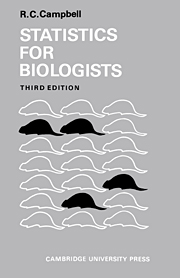Book contents
- Frontmatter
- Contents
- PREFACE
- PREFACE TO SECOND EDITION
- PREFACE TO THIRD EDITION
- 1 WHAT IS STATISTICS ABOUT?
- 2 PRESENTING THE INFORMATION CONTAINED IN ONE SAMPLE
- 3 COMPARING SEVERAL SAMPLES
- 4 ASSOCIATION
- 5 CHOOSING BETWEEN ACTIONS
- 6 THE NORMAL DISTRIBUTION
- 7 THE NORMAL VARIABLE IN EXPERIMENTS AND SURVEYS
- 8 ASSOCIATED NORMAL VARIABLES
- 9 SOME NON-NORMAL DISTRIBUTIONS
- FURTHER READING
- REFERENCES
- APPENDIX: TABLES AND FIGURES FOR STATISTICAL TESTS AND EXERCISES
- INDEX
1 - WHAT IS STATISTICS ABOUT?
Published online by Cambridge University Press: 05 June 2012
- Frontmatter
- Contents
- PREFACE
- PREFACE TO SECOND EDITION
- PREFACE TO THIRD EDITION
- 1 WHAT IS STATISTICS ABOUT?
- 2 PRESENTING THE INFORMATION CONTAINED IN ONE SAMPLE
- 3 COMPARING SEVERAL SAMPLES
- 4 ASSOCIATION
- 5 CHOOSING BETWEEN ACTIONS
- 6 THE NORMAL DISTRIBUTION
- 7 THE NORMAL VARIABLE IN EXPERIMENTS AND SURVEYS
- 8 ASSOCIATED NORMAL VARIABLES
- 9 SOME NON-NORMAL DISTRIBUTIONS
- FURTHER READING
- REFERENCES
- APPENDIX: TABLES AND FIGURES FOR STATISTICAL TESTS AND EXERCISES
- INDEX
Summary
Random variation
The simplest biological observations are qualitative, but when we try to refine them we usually find it necessary to quantify them in some way. ‘Grass is green’ sounds a simple and reasonable observation but if we explore its implications we come very soon to further questions, such as ‘Is it always green? Is it as green in Cambridge, in the drier east of England, as in Hereford, in the wetter west of the country? Are all varieties equally green?’ These queries leave us needing to measure greenness; when we answer them we shall have quantitative observations.
The progression from qualitative to quantitative is found in all the sciences, and is not by itself enough to explain why statistical methods are of special use to the biologist. The extra reason is the variability of the biologists' material. If we take observations to try to answer the first question in the preceding paragraph, we find that even on a single day different samples of grass exhibit different degrees of greenness. If we measure greenness on five samples today and on five more in a week's time, the ten measurements may well all be different and the range of values covered by the first five may overlap that of the second five. This is a simple example of biological variation; the purpose of statistical methods is to reach worthwhile quantitative conclusions in its presence.
- Type
- Chapter
- Information
- Statistics for Biologists , pp. 1 - 12Publisher: Cambridge University PressPrint publication year: 1989



